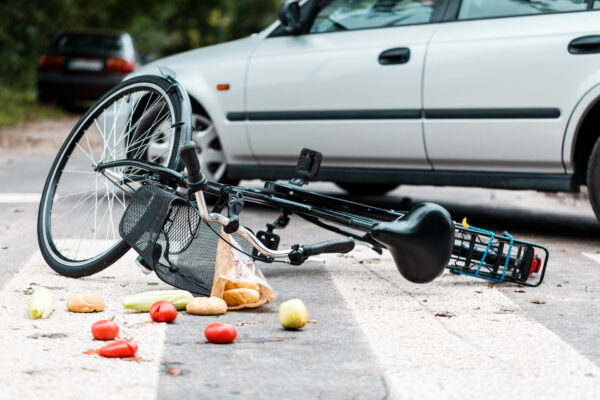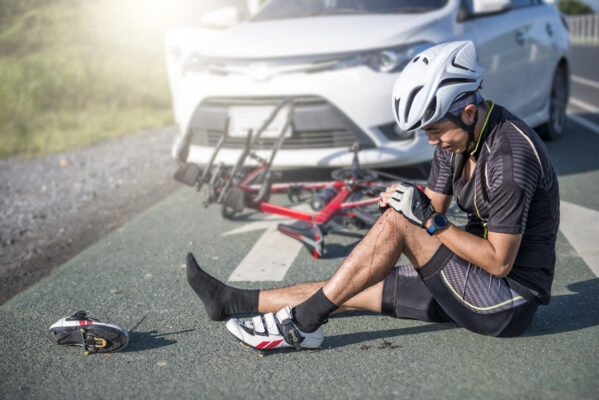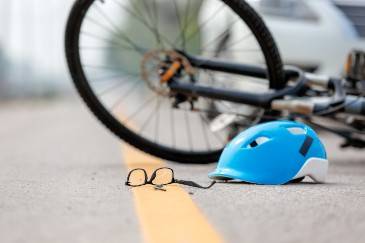Johns Creek, Georgia, with its scenic landscapes and well-maintained streets, has become an increasingly popular destination for cyclists. As more individuals embrace cycling for commuting and recreational purposes, understanding the city’s bicycle laws and their application in the event of accidents becomes crucial. This page aims to shed light on Johns Creek’s bicycle regulations and offer insights into how these laws apply in the unfortunate event of a bicycle accident.
Bicycle Laws in Johns Creek
Helmet Requirement
While Georgia state law does not mandate helmet use for all cyclists, Johns Creek has its own set of regulations. The city encourages cyclists of all ages to wear helmets, especially for those under 16 years old.
Traffic Laws
Cyclists in Johns Creek are considered vehicle operators and must obey traffic laws, signals, and signs. This includes stopping at stop signs and traffic signals, yielding the right-of-way, and signaling turns.
Bicycle Lanes
Johns Creek has made commendable efforts to enhance cycling infrastructure, including designated bicycle lanes. Cyclists should use these lanes whenever available and adhere to the specific rules governing their use.
Sidewalk Riding
Cyclists are generally permitted to ride on sidewalks in Johns Creek unless otherwise posted. However, it’s crucial to exercise caution and yield the right-of-way to pedestrians.
DUI Laws
Riding a bicycle under the influence of alcohol or drugs is illegal in Johns Creek, just as it is for motorists. Violators may face fines, penalties, or even arrest.
Bicycle Accidents in Johns Creek
Reporting an Accident
In the unfortunate event of a bicycle accident, it’s essential to report the incident to law enforcement. This creates an official record of the event and facilitates the resolution of potential legal matters.
Seek Medical Attention
Regardless of the severity of the accident, seeking prompt medical attention is crucial. Documenting injuries and obtaining medical records can be valuable in the event of legal proceedings.
Collect Evidence
If possible, collect evidence at the accident scene. This may include photographs, witness statements, and any other pertinent information that can help establish the circumstances surrounding the incident.
Legal Assistance
Consult with an attorney experienced in handling bicycle accidents in Johns Creek. They can provide guidance on the relevant laws, assess liability, and help pursue compensation for damages.
Insurance Considerations
Understanding the insurance implications of a bicycle accident is crucial. This includes determining whether the cyclist’s auto insurance or the at-fault party’s insurance may provide coverage for medical expenses and damages.
Johns Creek’s commitment to promoting cycling is evident through its bicycle-friendly infrastructure and regulations. Cyclists and motorists alike must be aware of and adhere to these laws to ensure a safe coexistence on the city’s roads. In the unfortunate event of a bicycle accident, understanding the legal landscape and seeking appropriate assistance can help navigate the aftermath and facilitate a smoother recovery process.
The Dangers of Distracted Driving and Bicycle Accidents in Georgia
Distracted driving is a pervasive issue on roads worldwide, and Georgia is no exception. When combined with vulnerable road users like cyclists, the consequences can be devastating. Bicycle accidents caused by distracted drivers have become a significant concern, leading to severe injuries and even fatalities. This article aims to shed light on the dangers of distracted driving in Georgia and the alarming rise in bicycle accidents, emphasizing the need for awareness, education, and stronger measures to ensure road safety for all.
The Rise of Distracted Driving
In the digital age, our lives are intertwined with technology. While smartphones and other gadgets have undoubtedly brought convenience, they have also introduced significant risks on the roads. Distracted driving encompasses any activity that diverts a driver’s attention away from the primary task of operating a vehicle. Examples include texting, talking on the phone, eating, grooming, or using in-car technologies.
Unfortunately, distracted driving has become an epidemic. According to the Georgia Governor’s Office of Highway Safety, distracted driving contributes to a staggering number of accidents in the state. In 2019 alone, there were over 2,000 accidents caused by distracted driving, resulting in numerous injuries and fatalities.
The Vulnerability of Bicyclists
Bicycles provide an eco-friendly and healthy means of transportation. However, due to their minimal protection, cyclists are extremely vulnerable on the roads, particularly when sharing them with distracted drivers. Even a momentary lapse of attention can lead to catastrophic consequences.
Georgia has seen a concerning rise in bicycle accidents caused by distracted drivers. These accidents often result from drivers failing to notice cyclists or misjudging their movements due to distractions. Consequently, cyclists suffer severe injuries, such as broken bones, head trauma, spinal cord injuries, and even death.
Promoting Road Safety and Awareness
To combat the dangers of distracted driving and bicycle accidents, it is crucial to raise awareness and educate both drivers and cyclists. Several steps can be taken to promote road safety and reduce the risks:
Public Education Campaigns: Government agencies, nonprofits, and other organizations should run extensive public education campaigns to inform the public about the dangers of distracted driving. These campaigns can highlight the potential consequences and emphasize the importance of undivided attention while driving.
Legislative Measures: Policymakers should enact and enforce stricter laws regarding distracted driving. Penalties for using mobile devices while driving should be increased, and law enforcement agencies should actively monitor and ticket offenders. Implementing hands-free laws can help discourage phone usage while driving.
Infrastructure Development: Creating dedicated bicycle lanes and improving cycling infrastructure can provide a safer environment for cyclists. Separating bicycles from motor vehicles reduces the risk of accidents caused by distracted drivers.
Technology Solutions: Automakers can play a significant role in curbing distracted driving by implementing advanced safety features in vehicles. These features may include smartphone integration, voice command systems, and collision avoidance systems that alert drivers to potential hazards.
Distracted driving poses a severe threat to road safety, particularly when it comes to vulnerable road users like bicyclists. The rise of bicycle accidents caused by distracted drivers in Georgia is a growing concern that demands immediate attention. Through public education campaigns, legislative measures, infrastructure development, and technological advancements, we can work towards creating safer roads for everyone.
It is our collective responsibility to prioritize road safety and minimize distractions while driving. By doing so, we can reduce the number of bicycle accidents, save lives, and ensure that Georgia’s roads become a safer place for all road users. Remember, when behind the wheel, keep your focus on the road and your hands on the wheel to protect yourself and those around you.
Common types of injuries sustained in bicycle accidents
Head Injuries
Head injuries are among the most serious and potentially life-threatening consequences of bicycle accidents. Traumatic brain injuries (TBIs) can range from mild concussions to severe brain damage. In many cases, wearing a helmet can mitigate the severity of head injuries, but it does not guarantee complete protection. Cyclists without helmets are at a significantly higher risk.
Impact on Claims: Head injuries often require extensive medical treatment, including hospitalization, rehabilitation, and long-term care. These costs can substantially impact a personal injury claim, leading to higher settlement demands or court awards.
Fractures and Orthopedic Injuries
Broken bones and orthopedic injuries are common in bicycle accidents. Cyclists can suffer fractures to the arms, legs, wrists, and shoulders. These injuries may necessitate surgery, physical therapy, and extended recovery periods.
Impact on Claims: Medical expenses, including surgeries and rehabilitation, can be significant. Additionally, the victim may experience lost wages due to time away from work during recovery. These costs should be factored into any personal injury claim.
Road Rash and Abrasions
When a cyclist is thrown from their bike during an accident, they are at risk of sustaining road rash and abrasions. These injuries occur when the skin scrapes against the road surface. While they may not be life-threatening, they can lead to infections and permanent scarring.
Impact on Claims: Claims for road rash injuries may include compensation for medical bills, scar treatment, and potential psychological trauma due to disfigurement.
Soft Tissue Injuries
Soft tissue injuries, such as sprains, strains, and ligament tears, are common in bicycle accidents. These injuries can cause chronic pain and limit a person’s mobility and quality of life.
Impact on Claims: Soft tissue injuries may require ongoing medical treatment and rehabilitation. Victims may seek compensation for medical expenses and pain and suffering.
Spinal Cord Injuries
In severe bicycle accidents, spinal cord injuries can occur. These injuries may result in partial or complete paralysis, dramatically altering a person’s life and requiring long-term medical care and adaptive equipment.
Impact on Claims: Claims involving spinal cord injuries can be extremely high due to the long-term nature of medical care and rehabilitation, home modifications, and loss of earning capacity.
Psychological Trauma
Bicycle accidents can also lead to psychological trauma, including post-traumatic stress disorder (PTSD), anxiety, and depression. These emotional injuries can affect a person’s daily life and ability to function.
Impact on Claims: Compensation for psychological trauma may be sought in a personal injury claim, particularly if it can be directly linked to the accident.
Bicycle accidents in Fulton County, Georgia, can result in a range of injuries, each with its own impact on personal injury claims. To navigate the claims process successfully, it’s essential for victims to seek prompt medical attention, document their injuries, and consult with an experienced personal injury attorney. Understanding the nature and severity of injuries sustained in a bicycle accident is crucial for ensuring fair compensation and holding responsible parties accountable. Staying safe while cycling by wearing helmets and following road safety rules remains the best prevention against such injuries and their associated legal challenges.
Understanding Bicyclists’ Rights and Responsibilities
In Georgia, bicycles are legally considered vehicles. This classification means that bicyclists are granted the same rights and responsibilities as drivers of motor vehicles. However, this also imposes on them the same obligations to follow traffic laws. Bicyclists must adhere to the same rules of the road that apply to cars and trucks. This includes obeying traffic signals, stopping at stop signs, yielding the right of way when necessary, and riding in the same direction as traffic. Georgia law mandates that bicyclists ride as far to the right side of the roadway as is practicable, except under certain conditions, such as when preparing to make a left turn or when it is unsafe to ride on the right side of the road due to hazards like debris or parked cars. This requirement underscores the importance of bicyclists being vigilant and aware of their surroundings at all times.
Georgia also allows bicyclists to ride two abreast in a single lane, as long as they do not impede the normal flow of traffic. This law recognizes the social aspect of bicycling while ensuring that it does not unduly disrupt traffic. However, in areas where the road narrows or where traffic is particularly heavy, cyclists are encouraged to ride single file to avoid creating a hazardous situation. The law does not require bicyclists to use bike lanes when they are available, but it is generally safer for cyclists to do so, especially on roads with high traffic volumes. Bike lanes provide a designated space for bicyclists, separating them from motor vehicle traffic and reducing the likelihood of accidents. However, the decision to use a bike lane ultimately rests with the cyclist, who must assess the safety and condition of the lane.

The Three-Foot Law and Its Impact
One of the most significant legal protections for bicyclists in Georgia is the “Three-Foot Law.” Enacted to enhance the safety of bicyclists on the road, this law requires drivers to maintain a minimum distance of three feet when overtaking a cyclist. The Three-Foot Law aims to prevent accidents caused by drivers passing too closely to bicyclists, a common occurrence that can lead to serious injuries or even fatalities. The law is straightforward but crucial, as it emphasizes the importance of giving cyclists adequate space on the road. By requiring a three-foot buffer, the law reduces the risk of collisions and encourages drivers to be more mindful of bicyclists sharing the road.
Despite the clarity of the Three-Foot Law, enforcing it can be challenging. It can be difficult for law enforcement officers to determine whether a vehicle maintained the required three-foot distance when passing a cyclist. As a result, the law’s effectiveness often relies on the awareness and willingness of drivers to comply. Public education campaigns have played a significant role in raising awareness about the Three-Foot Law, helping to foster a culture of respect and safety on the road. However, bicyclists should remain vigilant and assertive when it comes to their safety. If a driver passes too closely, cyclists should report the incident to the authorities, providing as much information as possible to help law enforcement take appropriate action.
I had the pleasure of working against Chris on a fairly complicated case. Chris was professional during the course of litigation, and undoubtedly maintained his clients’ interests as the primary focus throughout. Due to Chris’ efficiency and advocacy for his clients, we were able to resolve the case for a reasonable amount, without spending unnecessary time and expenses. I hope to have more cases with Chris in the future, and would have no hesitation recommending Chris to handle complex personal injury matters.” - Paul T.
Helmet Laws and Bicyclist Safety
In Georgia, wearing a helmet while riding a bicycle is mandatory for all riders under the age of 16. Although there is no legal requirement for adult cyclists to wear helmets, it is strongly recommended as a vital safety measure. Helmets significantly reduce the risk of head injuries in the event of an accident, which can be life-saving. The decision to wear a helmet should not be influenced by the absence of a legal mandate but rather by the understanding of the risks involved in cycling without one. For young riders, the helmet law is non-negotiable, and parents or guardians are responsible for ensuring that children comply with this requirement. This law reflects the state’s commitment to protecting its youngest cyclists, who are particularly vulnerable on the road.
While the law does not extend to adults, it is important for all cyclists to recognize the value of wearing a helmet. Accidents can happen in an instant, and even a minor fall can result in a serious head injury if a helmet is not worn. Bicyclists should also consider other protective gear, such as reflective clothing, lights, and mirrors, to enhance their visibility and safety on the road. Wearing a helmet and other protective gear should be viewed as a personal responsibility that goes beyond the law. It is an investment in one’s safety that can prevent life-altering injuries and ensure that cycling remains a safe and enjoyable activity.
Sidewalk Riding and Crosswalks
Georgia law allows bicyclists to ride on sidewalks in certain situations, although this practice is generally discouraged in urban areas where pedestrian traffic is heavy. Bicyclists who choose to ride on the sidewalk must yield the right of way to pedestrians and give an audible signal before overtaking and passing them. The law recognizes that there may be instances where riding on the sidewalk is safer than riding on the road, particularly in areas with high traffic volumes or where the road conditions are poor. However, cyclists should use sidewalks judiciously and be mindful of pedestrians, who may not expect or anticipate encountering a bicycle.
When crossing the street, bicyclists are permitted to use crosswalks, but they must do so with caution. Just like pedestrians, cyclists using a crosswalk have the right of way, but they must ensure that it is safe to cross before doing so. It is important for bicyclists to dismount and walk their bikes across the crosswalk, particularly in busy intersections, to avoid accidents. Riding through a crosswalk at speed can be dangerous and may not give drivers enough time to react. This approach also reinforces the cyclist’s awareness of their surroundings and helps prevent accidents.
Dealing with Insurance Steps to File a LawsuitRelated Videos
DUI Laws and Bicycling
Interestingly, Georgia’s DUI laws apply to bicyclists as well as motorists. This means that a bicyclist can be charged with a DUI if they are found to be operating their bicycle while under the influence of alcohol or drugs. The application of DUI laws to bicyclists underscores the potential dangers of impaired cycling, which can lead to accidents that harm the cyclist, pedestrians, and other road users. Bicyclists who are charged with a DUI face the same penalties as drivers of motor vehicles, including fines, possible jail time, and a criminal record. The law treats impaired cycling with the same seriousness as impaired driving, recognizing that both behaviors can have devastating consequences.
Bicyclists must understand that riding under the influence is not only illegal but also extremely dangerous. Alcohol and drugs impair judgment, reaction time, and coordination, all of which are essential for safe cycling. The risks are compounded by the vulnerability of bicyclists, who have less protection than motorists in the event of an accident. Bicyclists should always make responsible choices and avoid riding if they have consumed alcohol or drugs. If necessary, they should arrange for alternative transportation or wait until they are sober before getting on their bike. This approach ensures their safety and the safety of others on the road.
The Role of Law Enforcement and Public Awareness
Law enforcement plays a crucial role in protecting bicyclists’ rights on the road. Officers are responsible for enforcing traffic laws, including those that apply to bicyclists. They also have the authority to issue citations to both cyclists and drivers who violate traffic laws, ensuring that everyone on the road adheres to the rules designed to keep them safe. However, the effectiveness of law enforcement in protecting bicyclists depends on public awareness and cooperation. Without widespread understanding of bicyclists’ rights and responsibilities, enforcement alone may not be sufficient to prevent accidents and ensure safety.
Public awareness campaigns are essential in educating both drivers and cyclists about the laws that protect bicyclists. These campaigns often focus on key issues such as the Three-Foot Law, the importance of wearing helmets, and the dangers of impaired cycling. By raising awareness, these initiatives help to create a culture of respect and safety on the road, where both motorists and bicyclists understand and appreciate each other’s rights. Education also empowers bicyclists to assert their rights and report violations, contributing to a safer environment for all road users. Communities, schools, and local governments play a critical role in promoting bicycle safety education, ensuring that both children and adults are informed about the laws and best practices for safe cycling.
Understanding Georgia’s Comparative Negligence Laws for Bicycle Accidents
Bicycling is a popular mode of transportation and a recreational activity enjoyed by many individuals in Georgia. However, sharing the road with motor vehicles can sometimes lead to accidents, resulting in injuries to cyclists. In such cases, understanding Georgia’s comparative negligence laws becomes crucial in determining liability and securing fair compensation for the injured party. This article aims to provide an overview of Georgia’s comparative negligence laws specifically related to bicycle accidents.
Comparative Negligence in Georgia
Georgia follows the legal principle of comparative negligence when determining liability in personal injury cases, including bicycle accidents. Under comparative negligence, the responsibility for an accident and resulting injuries is assigned based on each party’s degree of fault. This means that even if a cyclist is partially at fault for the accident, they may still be entitled to receive compensation for their injuries, albeit reduced by their percentage of fault.
The 50% Bar Rule
Georgia adheres to the “50% Bar Rule” concerning comparative negligence. According to this rule, an injured party can recover damages only if their percentage of fault in the accident is less than 50%. In other words, if the cyclist is found to be 50% or more at fault, they will be barred from seeking compensation from the other party involved in the accident.
Example Scenario
To better understand how comparative negligence works in practice, let’s consider an example. Suppose a cyclist and a motorist collide at an intersection where the cyclist failed to stop at a red light, while the motorist was speeding. If a court determines that the cyclist was 30% at fault for the accident and the motorist was 70% at fault, the cyclist may be entitled to seek compensation from the motorist, but the amount of compensation will be reduced by 30% to account for their degree of fault.
Importance of Evidence and Legal Representation
In cases involving bicycle accidents, gathering strong evidence is crucial to establish liability and determine the percentage of fault. It is essential for the injured cyclist to document the accident scene, gather witness statements, obtain medical records, and consult with an experienced personal injury attorney.
An attorney knowledgeable in Georgia’s comparative negligence laws can guide the injured party through the legal process, protecting their rights, and advocating for fair compensation. They will work to negotiate with insurance companies or represent the injured cyclist in court, if necessary, to ensure that their interests are represented effectively.
Contributory Negligence and Insurance Adjustments
It’s worth noting that Georgia follows a modified comparative negligence rule with a “51% bar” when it comes to insurance claims. Under this rule, if the injured cyclist is found to be 51% or more at fault for the accident, they may be completely barred from recovering any damages from the other party’s insurance company.
Therefore, insurance adjusters will closely evaluate the facts surrounding the accident and may try to assign a higher percentage of fault to the cyclist to avoid paying compensation. Having legal representation during the negotiation process can help protect the injured cyclist’s rights and ensure a fair assessment of fault.
Understanding Georgia’s comparative negligence laws is vital for anyone involved in a bicycle accident seeking compensation for their injuries. By recognizing the principles of comparative negligence, the 50% Bar Rule, and the importance of evidence and legal representation, injured cyclists can navigate the legal process more effectively. Seeking assistance from an experienced personal injury attorney can greatly enhance their chances of securing fair compensation and ensuring their rights are protected in the aftermath of a bicycle accident in Georgia.
How can The Gunnels Law Firm LLC help you on Bicycle Accident cases in Johns Creek, GA
At The Gunnels Law Firm LLC, we understand the unique challenges that arise in bicycle accident cases, and we are committed to providing comprehensive legal assistance to individuals in Johns Creek, GA, who have been involved in such incidents. Our experienced team is dedicated to helping clients navigate the legal complexities surrounding bicycle accidents, ensuring they receive the compensation and support they deserve.
Legal Experience
Our firm boasts a team of skilled attorneys with extensive experience in personal injury law, including bicycle accidents. We stay abreast of the latest developments in Georgia’s bicycle laws to provide our clients with the most relevant and effective legal representation.
Investigation and Evidence Gathering
We understand the importance of a thorough investigation. Our team will work diligently to gather evidence, including accident reports, witness statements, and any other pertinent information, to establish the facts surrounding the incident.
Liability Assessment
Determining liability is a crucial aspect of bicycle accident cases. Our attorneys will assess the circumstances of the accident to identify the responsible party or parties. Whether it involves a negligent motorist, poorly maintained roads, or another factor, we strive to build a strong case on your behalf.
Medical Advocacy
We recognize the impact that bicycle accidents can have on your health and well-being. Our firm will work closely with medical professionals to ensure that the extent of your injuries is thoroughly documented. This information is crucial for pursuing fair compensation for medical expenses and other damages.
Negotiation and Litigation
The Gunnels Law Firm LLC is adept at negotiation and, when necessary, litigation. We will engage with insurance companies and, if a fair settlement cannot be reached, we are prepared to take your case to court to protect your rights and interests.
Compassionate Client Support
We prioritize providing compassionate and personalized support to our clients. Going through a bicycle accident can be a challenging experience, and we are here to guide you through the legal process, answering your questions, and addressing your concerns every step of the way.
Maximizing Compensation
Our goal is to maximize the compensation you receive for your damages, including medical expenses, lost wages, pain and suffering, and property damage. We diligently advocate for your rights to ensure you receive a fair and just settlement.
If you or a loved one has been involved in a bicycle accident in Johns Creek, GA, The Gunnels Law Firm LLC is here to help. Contact us for a confidential consultation to discuss the details of your case and explore your legal options. Our commitment is to provide you with effective and personalized legal representation tailored to your unique situation.
Mistakes to Avoid After a Bicycle Accident
In this video, our Atlanta injury attorney discusses what mistakes to avoid after a bicycle accident to make sure your rights are protected.
Get Our FREE Bicycle Accident Guide
Question:
What mistakes should I avoid after a bicycle accident?
Answer:
 When we have people come to us after being injured in a bicycle accident, they’ve often done things that harm their case without even knowing it. It’s very important to make sure you avoid these problems. First, we frequently see people that have been injured on bikes destroying evidence that could be helpful to us. Make sure that clothing is preserved. Oftentimes, you’ll have bloody clothing, or maybe clothing that had to be cut off of you at the emergency room. Helmets, pads, shoes, and bicycles may have been destroyed or mangled during the accident, but you shouldn’t dispose of this crucial evidence.
When we have people come to us after being injured in a bicycle accident, they’ve often done things that harm their case without even knowing it. It’s very important to make sure you avoid these problems. First, we frequently see people that have been injured on bikes destroying evidence that could be helpful to us. Make sure that clothing is preserved. Oftentimes, you’ll have bloody clothing, or maybe clothing that had to be cut off of you at the emergency room. Helmets, pads, shoes, and bicycles may have been destroyed or mangled during the accident, but you shouldn’t dispose of this crucial evidence.
Another thing that we see at times, although not as often in bike cases, is people who don’t do a good job of getting immediate medical attention. It’s important to go ahead and get medical treatment from the time that you begin to feel pain so that you can correlate your pain to the injuries you suffered in this collision. This is more prevalent in car wreck cases because the impact people get in bike wrecks is often so much more severe.
Always get treated immediately. Don’t let a long time pass before you have treatment if you’re experiencing pain. Another thing we see people do that can really harm their case is not following through with their treatment. We oftentimes see people who tell their physicians that their pain has resolved, when in fact, it hasn’t. They are just getting impatient with the treatment process. Make sure that you don’t underestimate your case. Don’t tell the doctors you are better when you’re not. Also, don’t allow gaps in your treatment to occur. When people don’t follow through and they go long periods of time where they haven’t gotten treatment, insurance companies will latch onto this and claim that they must not have been as injured as they say they are or they would have been getting that regular treatment. Don’t give them that opportunity.
Finally, make sure you immediately hire an attorney that is experienced in handling these types of cases. Attorneys are going to want to get out to the scene and preserve any evidence. There could be blood on the concrete that will eventually disappear. There could be scuff marks in the asphalt from where the bike hit. There could be remnants of the bike or the car that are still around. Make sure you hire someone that knows what they’re doing and has experience handling bicycle cases.
Were you or a loved one seriously injured while riding a bike in Georgia and have questions about what mistakes to avoid after a bicycle accident?
Contact the experienced Atlanta bicycle accident lawyers at Gunnels Injury Law today to arrange a free consultation and case evaluation.
Let our experience work for you.
Subscribe to Our YouTube Channel
Out of Town Legal Resources
We are always looking for attorneys and helpful online resources in other parts of the country. We found this personal injury lawyer in Austin, TX that did a great job with their online legal resources. If you or a loved one have questions about bicycle accidents in Texas, take a look at their online bicycle accident resources.


